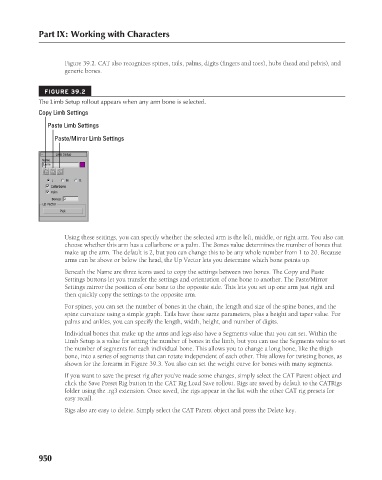Page 998 - Kitab3DsMax
P. 998
Part IX: Working with Characters
Figure 39.2. CAT also recognizes spines, tails, palms, digits (fingers and toes), hubs (head and pelvis), and
generic bones.
FIGURE 39.2
The Limb Setup rollout appears when any arm bone is selected.
Copy Limb Settings
Paste Limb Settings
Paste/Mirror Limb Settings
Using these settings, you can specify whether the selected arm is the left, middle, or right arm. You also can
choose whether this arm has a collarbone or a palm. The Bones value determines the number of bones that
make up the arm. The default is 2, but you can change this to be any whole number from 1 to 20. Because
arms can be above or below the head, the Up Vector lets you determine which bone points up.
Beneath the Name are three icons used to copy the settings between two bones. The Copy and Paste
Settings buttons let you transfer the settings and orientation of one bone to another. The Paste/Mirror
Settings mirror the position of one bone to the opposite side. This lets you set up one arm just right and
then quickly copy the settings to the opposite arm.
For spines, you can set the number of bones in the chain, the length and size of the spine bones, and the
spine curvature using a simple graph. Tails have these same parameters, plus a height and taper value. For
palms and ankles, you can specify the length, width, height, and number of digits.
Individual bones that make up the arms and legs also have a Segments value that you can set. Within the
Limb Setup is a value for setting the number of bones in the limb, but you can use the Segments value to set
the number of segments for each individual bone. This allows you to change a long bone, like the thigh
bone, into a series of segments that can rotate independent of each other. This allows for twisting bones, as
shown for the forearm in Figure 39.3. You also can set the weight curve for bones with many segments.
If you want to save the preset rig after you’ve made some changes, simply select the CAT Parent object and
click the Save Preset Rig button in the CAT Rig Load Save rollout. Rigs are saved by default to the CATRigs
folder using the .rg3 extension. Once saved, the rigs appear in the list with the other CAT rig presets for
easy recall.
Rigs also are easy to delete. Simply select the CAT Parent object and press the Delete key.
950

